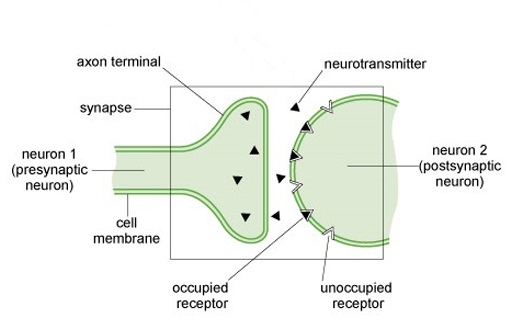2.2 Neurons and neurotransmitters
Meet ‘neurons’. These are what would colloquially be referred to as ‘brain cells’, although the brain is made up of many other types of cells as well. This short video introduces the cells’ structure and function.

Transcript: Video 4 Neurons
As you’ve just seen, neurons are special cells in the brain which transmit electrical pulses. This is how the different parts of the brain ‘talk’ to each other, and indeed to the rest of the body via other neurons in the ‘nervous system’. You can think of this as being like the body’s electrical wiring.
Neurons in the brain form a communication network, as illustrated in this short video clip.

Transcript: Video 5 Neuron networks
The diagram in Figure 2 illustrates a typical neuron. The microscopic cell body contains important cellular components, such as the nucleus that houses genetic material. Typically, the branching dendrites receive incoming messages from neighbouring neurons, which are then integrated together. If the neuron ‘fires’, the axon carries the signal as an electrical pulse to the axon terminals. The length of an axon varies enormously, from a fraction of a millimetre to a metre or more. The longest axons in humans belong to neurons in the sciatic nerve, which connects the base of the spine to the toes.
The connections between neurons are called ‘synapses’. In most cases, a signal is transmitted across the small gaps between neurons by chemicals called neurotransmitters, rather than by electrical pulses. Some neurotransmitters act to ‘excite’ neurons while others have an inhibitory effect, but if the overall chemical signal is strong enough then adjacent neurons will ‘fire’. There are many different neurotransmitters, but you may be familiar with a few names already, like adrenaline, endorphin, dopamine and histamine.
The diagram in Figure 3 shows one neuron releasing chemical neurotransmitters, triggered by the electrical pulses travelling along the axon. The surface membrane of the next neuron contains specific receptors for these neurotransmitters, acting somewhat like a lock-and-key mechanism. These chemical messages can be passed to the branching dendrites of more than one neuron, like in the simple network shown in Figure 4.
Some neurons can ‘pass on the message’ to hundreds or even thousands of other neurons in this way. With around 100 billion neurons in the brain – similar to the number of stars in an entire galaxy – this makes many trillions of connections in total! And it isn’t just the number of connections which is astounding, but the number of messages which are being sent – a neuron can fire off hundreds of messages each second. Video 6 visually demonstrates a few of this section’s concepts.




